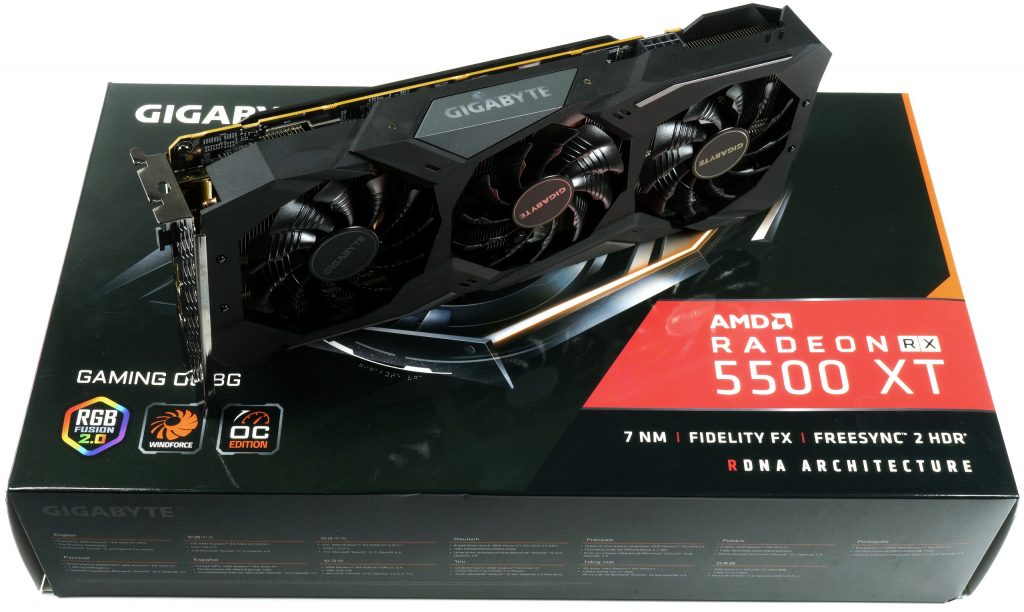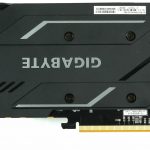After i created the launch article about AMD's new Radeon RX 5500 XT and also a first overclocking article with the MorePowerTool, I now dedicate myself with the intention of one of the slightly more expensive 8GB board partner cards, which are currently listed at just over 230 Euros Is. The fact is that this price will probably have to move down soon when the Radeon RX 5600 XT is launched on 21.01.2020 at an RRP of 279 euros. Otherwise it will be tight for Navi 14, especially since with the OEM variant of the RX 5600 XT a further trimmed Navi-10 chip appears.
Otherwise, the card largely corresponds to the MSI model tested for launch, which is also shown by the benchmarks, which run completely identically. Same clock, again the same result – as recently with the Sapphire RX 5500 XT Pulse 8GB. It is always astonishing how close these cards are, all of which have already appeared on the market with factory overclocking. In the end, the data is interchangeable, so this time I forgo the detailed benchmarks and all the detail graphics and only link to the launch. The results are again 1:1 transferable.
The 158 mm2 chip is manufactured by TSMC in the well-known 7 nm process and contains 6.4 billion transistors. The total of 22 Compute Units includes 1408 stream processors, 88 TMUs and 32 ROPs. The aggregated 128-bit memory bus represents the connection of the total of 4 memory modules, which are installed as either 1 GB or 2 GB modules, depending on the memory configuration of a total of 4 or 8 GB. At 224 GB/s, the memory bandwidth is fully within the limits of what the GDDR6 RAM at 14 Gbps provides.
All the details about AMD's new RDNA I had already explained in detail in the launch article to the RX 5700 (XT) and if you want, you can do this again under "AMD Radeon RX 5700 and RX 5700 XT in the test – The Raytracing-free coffin nail from Vega and up to 2.1 GHz clock under water" Read. That's why I'm now focusing on my test object, because it counts on the square and not on paper. Let's see who sinks whom here now.
Gigabyte RX 5500 XT Gaming OC 8 GB
The black abS injection-moulded cover is loosened by some Gunmetal-optic applications, the recesses of the three small 7.5 cm fans are almost octagonal and make the fans appear larger than they actually are. At the top, besides the 8-pin power supply connection, there is also a backlit gigabyte lettering, but that was also noticeable.
At 692 grams, the card is still relatively light and measures 28.2 cm from the outer edge of the slot panel to the outer edge of the radiator cover. With the 10.5 cm from the top of the motherboard slot to the top edge of the cover, it is hardly higher than the slot panel and the installation depth ("thickness") of 3.5 cm makes it a real dual slot card. The backplate made of ABS is purely optical in nature and is not actively involved in the cooling concept, as well as. Unfortunately, plastic does not give this away.
The slot bezel does not allow any warm exhaust air directly, as the cooling fins are vertically aligned due to the three fans. So everything disappears as usual only in the depths of the housing. With one HDMI 2.0 port and three DisplayPort 1.4 connectors, there are plenty of variants to connect to the monitor.
| Installation length (gross) | 28.2 cm |
| Installation height (gross) | 10.5 cm |
| Installation depth front (gross) | 3.5 cm |
| Installation depth rear (gross) | 0.5 cm (backplate) |
| Weight: | 692 g |
| Connections: | 1x HDMI 2.0 3x DisplayPort 1.4 1x 8-pin PCIe Power Supply |
| Cooler cover: | ABS injection moulding, black with applications |
| Fan: | 3x 7.5 cm rotors with 11 rotor blades each |
The latest version of GPU-Z gives us an initial overview of the electrical data, where Gigabyte has raised the base clock to 1685 MHz, but the "boost" corresponds to that of the competitors. However, this does not affect the overall performance, as the final bar is again, as with all other cards, on average in the boost specification:
Let's quickly compare some of the relevant maps in table form. The overview of the relevant comparison maps then looks like this:
| Msi GeForce GTX 1650 Super Gaming X 4GB |
Gigabyte RX 5500 XT Gaming OC 8 GB |
Msi GeForce GTX 1660 Gaming X 6GB |
Msi GeForce GTX 1060 Gaming X 6GB |
|
| Architecture (GPU) |
Turing (TU116-250) | Navi 14 | Turing (TU116-300) | Pascal (GP106-400) |
| Cores / SP |
1280 | 1408 | 1408 | 1280 |
| Texture Units |
80 | 88 | 88 | 80 |
| Base Clock Rate |
1530 MHz | 1685 MHz | 1530 MHz | 1595 MHz |
| GPU Boost Rate |
1755 MHz | 1845 MHz | 1860 MHz | 1810 MHz |
| Storage expansion |
4GB GDDR6 | 8 GB GDDR6 | 6 GB GDDR5 | 6 GB GDDR5 |
| Storage bus |
128-bit | 128-bit | 192-bit | 192-bit |
| Bandwidth |
192 GB/s | 224 GB/s | 192 GB/s | 192 GB/s |
| Rops |
32 | 32 | 40th | 48 |
| L2 Cache |
1 MB | 2 MB | 1.5 MB | 1.5 MB |
| Tdp |
175 W | 145 W * |
120 W | 120 W |
| Transistors |
6.6 billion | 6.4 billion | 6.6 billion | 4.4 billion |
| The size |
284 mm2 | 158 mm2 | 284 mm2 | 200 mm2 |
Test system and evaluation software
As always, I benchmark with my own PresentMon GUI and the interpreter software, which fills the Excel charts and the graphical output (and only the) so extra- or so. interpolates that all graphs are exactly long, creating a uniform and comparable time line. The remaining evaluations up to percentiles and bar graphics are based on the real raw data from the measurement. The benchmark system is new and has been upgraded in some areas. That's one of the reason why I've completely re-benchmarked all the games and cards.
I have also summarized the individual components of the test system in tabular form.
| Test System and Equipment |
|
|---|---|
| Hardware: |
Intel Core i9-9900 K 4x 8GB G.Skill FlareX DDR4 3200 |
| Cooling: |
Alphacool Ice Block XPX (1151), XPX Pro (AM4, 2066) Alphacool Ice Grinder (modified) Thermal Grizzly Kryonaut |
| Case: |
Lian Li T70, Raijintek Paean Open Benchtable |
| Monitor: | BenQ PD3220U |
| Power Consumption: |
Non-contact direct current measurement on PCIe slot (riser card) |
| Thermal Imager: |
1x Optris PI640 + 2x Xi400 Thermal Imagers Pix Connect Software Type K Class 1 thermal sensors (up to 4 channels) |
| Acoustics: |
NTI Audio M2211 (with calibration file) Steinberg UR12 (with phantom power for the microphones) Creative X7, Smaart v.7 Own anechoic chamber, 3.5 x 1.8 x 2.2 m (LxTxH) Axial measurements, perpendicular to the center of the sound source(s), measuring distance 50 cm Noise emission in dBA (slow) as RTA measurement Frequency spectrum as graphic |
| Os: | Windows 10 Pro (1909, all Updates) |
GIGABYTE Radeon RX 5500 XT Gaming OC 8G, 8GB GDDR6, HDMI, 3x DP (GV-R55XTGAMING OC-8GD)













































Kommentieren